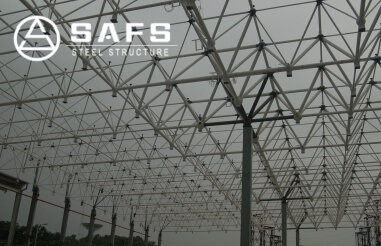Dapeng Town Industrial Park, Tongshan District, Xuzhou City, Jiangsu Province, China
Earthquakes are a major threat to the safety of building structures. As a common structural form in modern buildings, the seismic performance of steel structure space frame is of vital importance. Understanding its seismic characteristics can provide a basis for structural design and optimization, and ensure the safety of buildings under earthquakes.
Material properties
Steel has high strength and good ductility. Under the action of earthquakes, steel structures can absorb and dissipate seismic energy through their own plastic deformation to avoid the collapse of the structure due to sudden fracture. Compared with brittle materials, this ductile characteristic of steel gives it a natural advantage in seismic resistance.
Structural system
Steel structure space frame is generally a three-dimensional space structure with good integrity. The rods are effectively connected by nodes and can work together. During an earthquake, the force can be reasonably transmitted and distributed in space to avoid damage caused by local stress concentration. Moreover, this structural form can be flexibly arranged and can be optimized according to different building functions and seismic load conditions.

Node connection
Nodes are the key parts of the seismic resistance of steel structure space frame. The performance of welded nodes and high-strength bolted nodes has a great influence on the seismic resistance of the structure. If the node design is unreasonable or the construction quality is poor, problems such as weld cracking and bolt loosening may occur under the action of an earthquake, leading to structural damage. For example, in some earthquake disasters, it was found that nodes with poor welding quality were the first to fail in an earthquake.
Component section characteristics
The cross-sectional shape, size and wall thickness of the component will affect its bearing capacity and energy dissipation capacity. For example, the performance of H-shaped steel columns and beams when subjected to bending moments and shear forces is different from other cross-sectional forms. Reasonable selection of component cross-sections can improve the seismic performance of the structure, increase the stiffness and strength of the structure, and ensure a certain ductility.
Structural layout and regularity
Symmetrical and regular structural layout is conducive to seismic resistance. In the design of steel structure space frames, the plane layout and vertical layout of the structure should be as regular as possible to avoid sudden changes in stiffness and mass concentration. If the structure has an irregular layout, such as irregular plane torsion or excessive vertical retraction, torsional effects and stress concentration will occur during an earthquake, reducing seismic performance.

Experimental research
The steel structure space frame model is subjected to quasi-static tests and shaking table tests. The quasi-static test can simulate the stress and deformation of the structure under the action of earthquake, obtain the hysteresis curve of the structure, and analyze its energy dissipation capacity and stiffness degradation. The shaking table test can reproduce the earthquake process more realistically, observe the response of the structure, including displacement, acceleration and other parameters, and provide intuitive data for the seismic design of the structure.
Numerical simulation
Using numerical simulation methods such as finite element analysis, the performance of steel structure space frames of different types and sizes under earthquake can be studied. By establishing an accurate model, the influence of various factors on the seismic performance of the structure can be analyzed, and a large number of parameter analyses and scheme comparisons can be carried out, which is low-cost and high-efficiency.
The steel structure space frame has good seismic performance, but it is necessary to fully consider factors such as node connection, component characteristics and structural layout during the design and construction process. Through experimental research and numerical simulation, its seismic performance can be deeply studied, the design method can be further optimized, the application safety of steel structure space frames in seismic areas can be improved, and strong support can be provided for the development of the field of building structure seismic resistance.